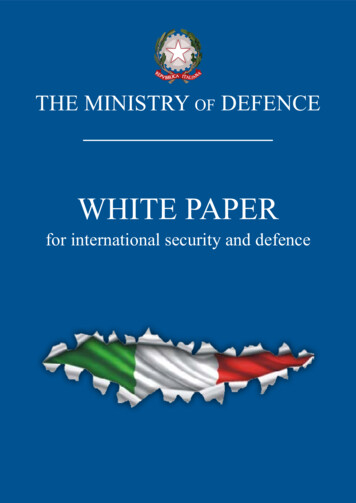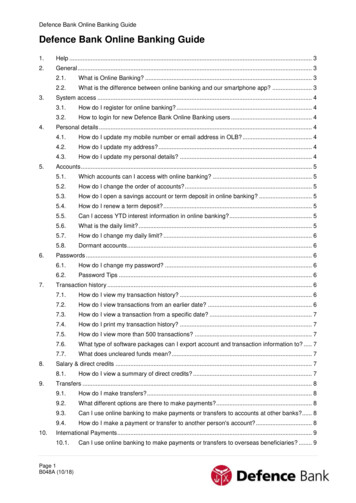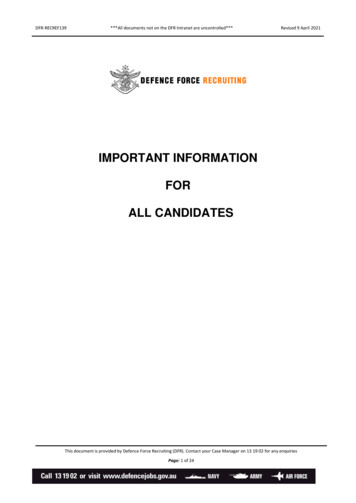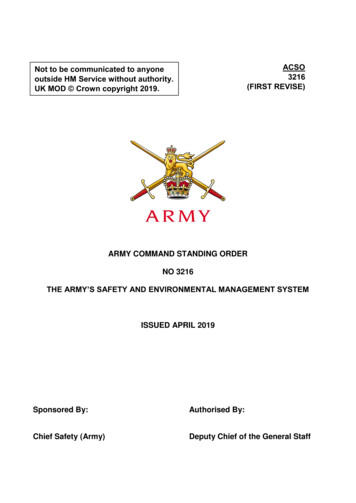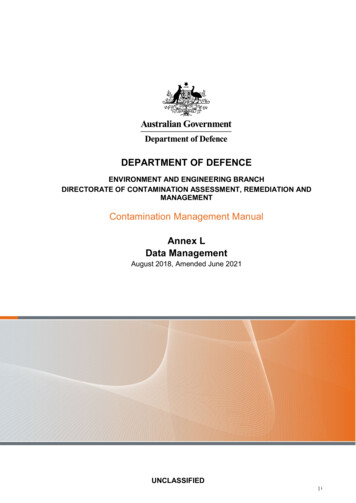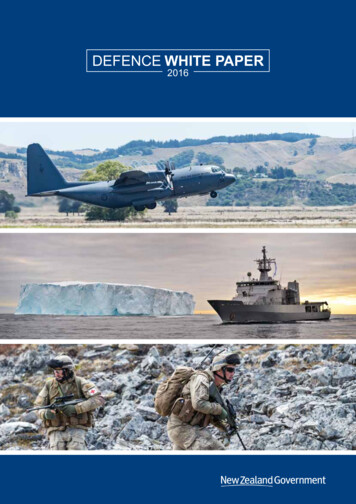
Transcription
DEFENCE white paper2016the defence white paper 20161
A Royal New Zealand Air Force NH90 Helicopter lands in Nasau, Koro Island to deliverpersonnel, aid and equipment. The New Zealand Defence Force deployed to Fiji toprovide Humanitarian Aid and Distaster Relief following Tropical Cyclone Winston.2the defence white paper 2016
ContentsPrime Ministerial Foreword5Ministerial Foreword7CHAPTER ONE: Executive Summary9CHAPTER TWO: National Security and Defence17CHAPTER THREE: New Zealand’s StrategicOutlook to 204025CHAPTER FOUR: Principal Roles for the New ZealandDefence Force37CHAPTER FIVE: Defence Force Capability45CHAPTER SIX: Generating a Skilled andSustainable Workforce55CHAPTER SEVEN: Affordability61CHAPTER EIGHT: Organisational Change65CHAPTER NINE: Regenerating the Defence Estate71CHAPTER TEN: Implementing this Defence White Paper75Glossary79Annex – Facts and Figures81The Ministry of Defence administers the Defence Act 1990.The latest Ministry of Defence publications are available from our website:www.defence.govt.nzThis information is protected by Crown copyright or the copyright of thirdparties. For permission to reproduce this information please contact theSecretary of Defence.ISBN: 978-0-478-27878-1 (Print)ISBN: 978-0-478-27877-4 (Online)Published by the Ministry of Defence, June 2016Freyberg House, 2-12 Aitken Street, Wellington 6144, New ZealandWebsite: www.defence.govt.nz Email: info@defence.govt.nzthe defence white paper 20163
Member of the Queen Alexandra’s Mounted Rifles working as part of7th Brigade (Australian Army) in the Shoalwater Bay Training Area.4the defence white paper 2016
Prime Ministerial ForewordI am pleased to introduce the Defence White Paper 2016, which sets outthe Government’s expectations for Defence over the coming decades.The 2016 White Paper reflects the Government’s commitment to a more regular cycle ofdefence policy updates.This is important for the security of New Zealand, its citizens and wider national interests.New Zealand’s strategic environment continues to evolve, sometimes rapidly, and ourdefence policy needs to adapt to these changes.This White Paper therefore builds on and, where necessary, adjusts the Government’sdefence policy priorities. Underlying these adjustments is a steadfast commitment tomaking independent policy decisions consistent with New Zealand’s values and interests.The earthquakes that devastated Christchurch and its surrounding areas underline theimportance of national resilience, and the critical role the Defence Force plays alongsideother government agencies in responding to national disasters.The Defence Force will continue to work with other government agencies to protect andadvance our national security interests in New Zealand, the South Pacific and around theworld. The protection of Southern Ocean resources and supporting our civilian presence inAntarctica also feature more prominently in this White Paper than in the past.Recent terror attacks are a tragic testament to the fact that terrorism remains an enduringglobal problem.The deployment of a military training team to build the capacity of the Iraqi Army in itsfight against the Islamic State of Iraq and the Levant reflects our determination to protectNew Zealand and to contribute to international peace and security.The Government has provided the Defence Force with a degree of funding certainty thatenables it to plan with confidence out to 2030 and beyond. The Defence Force is wellplaced to continue contributing to New Zealand’s national security now and into the future.Rt Hon John KeyPrime Ministerthe defence white paper 20165
Operations Room onboard HMNZS Te Kaha.6the defence white paper 2016
Ministerial ForewordThe Defence White Paper 2016 provides the foundation for New Zealand’ssecurity now and into the future at a time of increasing instability anduncertainty in the international strategic environment.The public’s views, from over 300 written submissions and meetings around the country,have informed the development of this White Paper, and are reflected in the Summary ofSubmissions Report.New Zealanders have been very clear about their expectations that the Defence Force hascapabilities that are up to date, interoperable with our close partners and able to respondto a range of contingencies.The importance of modern, combat-focussed capabilities, and having the right people tooperate them, was a consistent theme of the Defence White Paper public consultation process.The New Zealand Defence Force must be flexible and able to conduct concurrentoperations, from humanitarian and disaster response, operating in the Southern Ocean andsupporting Antarctic operations, to participating in international coalition deployments.The force structure set out in this White Paper will maintain the Defence Force’s flexibilityand depth of capability to meet future security challenges within our immediateenvironment and further afield.These challenges include maintaining an awareness of and an ability to respond to activitiesin New Zealand’s Exclusive Economic Zone, supporting New Zealand’s presence in Antarcticaand the Southern Ocean, as well as increasing cyber threats to Defence Force networks.In addition to maintaining the Defence Force’s existing mix of capabilities, the Governmentwill invest in: ice-strengthening the planned third offshore patrol vessel and replacement navaltanker; better supporting sea-to-shore operations with a littoral operations support vesselthat can operate in low to medium threat environments; an air surveillance capability to better enable the Defence Force to undertake airsurveillance operations at home and overseas; a cyber security support capability for the protection of Defence Force networks,platforms and people; and additional defence intelligence personnel to support military operations.The extensive analysis undertaken as part of the development of this White Paper hasenabled the Government to signal a commitment to a portfolio of planned Defencecapability investments valued at close to 20 billion over the next 15 years.This White Paper also reflects Defence’s commitment to balancing costs against the needto attract and retain skilled personnel, modernise its Estate, and enhance the managementof its increasingly sophisticated portfolio of defence capabilities.Hon Gerry BrownleeMinister of Defencethe defence white paper 20167
A New Zealand Defence Force Light Armoured Vehicle working in the Australian bush,as part of 7th Brigade (Australian Army) in the Shoalwater Bay Training Area.8the defence white paper 2016
Chapter One: Executive SummaryIntroduction1.1This Defence White Paper sets out the Government’s defence policy objectives, andhow the Defence Force will be structured and equipped to deliver on these objectivesout to 2030 and beyond.1.2Like its predecessor, this White Paper builds on a substantive body of work. This workincludes the Defence Assessment 2014, a comprehensive review of the internationalstrategic environment and its implications for Defence policy and capability.1.3Defence, which includes the Defence Force and Ministry of Defence, continues tomanage the affordability pressures that come with maintaining a modern militarywell-positioned to negotiate the challenges of an evolving strategic environment.1.4This White Paper is therefore also informed by work on the long-term capital andoperating costs associated with New Zealand’s current and planned mix of defencecapabilities, including the Defence Mid-point Rebalancing Review in 2013.1.5This White Paper has been developed in close consultation with other governmentagencies, and with members of the Ministerial Advisory Panel. The views of the NewZealand public, including those of New Zealand’s academic community, were soughtin the development of this White Paper.National Security and Defence1.6Defence is a key part of New Zealand’s broader security system, and works alongsideother government agencies to protect and advance New Zealand’s security interests.In particular, Defence contributes to New Zealand’s security through:1.7 the promotion of a safe, secure and resilient New Zealand, including its borderand approaches; the preservation of a rules-based international order which respects nationalsovereignty; a network of strong international relationships; and the maintenance of New Zealand’s prosperity via secure sea, air and electroniclines of communication.New Zealand’s national security interests, in combination with its strategic outlook,are the key factors shaping the roles and tasks the Defence Force must be prepared toundertake.the defence white paper 20169
Strategic Outlook to 2040Overarching security issues1.8There have been a number of positive developments in the international environmentsince the publication of the last Defence White Paper, including the continued rise ofa more prosperous Asia, and a South Pacific which has remained more stable thanexpected.1.9New Zealand has a critical interest in the maintenance of security in the Asia-Pacificregion as well as in growing and expanding its relationships. Any major conflictwould have flow on effects for peace and security beyond the region.1.10 New Zealand continues to benefit from the economic opportunities associated withAsia’s growth, but tensions in the region, which are now greater than they werefive years ago, are cause for concern. In addition to the marked increase in defencespending by countries across the region, and in some cases changes in defenceposture, the shifting distribution of power also means that Asia is the focus of acomplex interplay of global interests.1.11 Overall the number of conflicts internationally has remained steady in the pastdecade, although conflicts within states now occur more frequently than thosebetween states, often involving multiple well armed and organised groups. Theseconflicts are often characterised by the higher threat levels previously associated withconflicts between states.1.12 The rules-based international order has come under greater pressure since 2010,most notably in the Middle East. With weak or non-existent governance, many fragileand failing states are becoming theatres in which wider interests are being contested.1.13 Since the last Defence White Paper was published in 2010, terrorist groups haveenhanced their ability to radicalise individuals and extended their global reach,particularly through the use of internet technology and social media.1.14 Advances in technology continue to enhance the ease with which knowledge is ableto be transferred. This is a positive development, and has a number of advantagesin the military context. However, increasing reliance on technology and informationnetworks is creating new vulnerabilities. The threat to systems that rely on networkedtechnologies such as the internet, industrial control systems and global positioningsatellites has increased markedly since 2010.1.15 New Zealand therefore has an interest in contributing to international cyberspace andspace efforts to protect this infrastructure from being exploited or disrupted.New Zealand, its immediate region, and the South Pacific1.16 New Zealanders can remain confident that the country does not face a direct militarythreat in the foreseeable future. Nonetheless, New Zealand’s ability to protect andadvance its security interests is becoming increasingly challenging as the strategicenvironment evolves.1.17 The size, intrinsic value and challenges associated with managing New Zealand’slarge maritime domain underline the significance of maritime threats to New Zealand.As activity in this domain increases, incidents requiring a New Zealand response aremore likely to occur.10the defence white paper 2016
1.18 New Zealand has a strong interest in the preservation of the natural environmentand stability in the Antarctica and Southern Ocean. In most cases the increasinginternational activity in the region is focussed on scientific research.1.19 Given its strong connections with South Pacific countries, New Zealand has anenduring interest in regional stability. The South Pacific has remained relativelystable since 2010, and is unlikely to face an external military threat in the foreseeablefuture. However, the region continues to face a range of economic, governance, andenvironmental challenges. These challenges indicate that it is likely that the DefenceForce will have to deploy to the region over the next ten years, for a response beyondhumanitarian assistance and disaster relief.Strong international relationships1.20 New Zealand will continue to protect and advance its interests by maintaining stronginternational relationships, with Australia in particular, and with its South Pacificpartners, with whom it maintains a range of important constitutional and historicallinks. While New Zealand has an array of international relationships, it makesindependent policy decisions consistent with its values, interests and size.Defence Force Roles and Tasks1.21 The Defence Force must be able to undertake a range of roles and tasks acrossdiverse geographical and operating environments. The principal roles of the DefenceForce are to: Defend New Zealand’s sovereign territory; Contribute to national resilience and whole of government security objectives; Meet New Zealand’s commitment as an ally of Australia; Support New Zealand’s civilian presence in the Ross Dependency of Antarctica,and participate in whole of government efforts to monitor and respond to activityin the Southern Ocean; Contribute to, and where necessary lead, operations in the South Pacific; Make a credible contribution in support of peace and security in the Asia-Pacificregion; Protect New Zealand’s wider interests by contributing to international peace andsecurity, and the international rule of law; Contribute to the advancement of New Zealand’s security partnerships; Participate in whole of government efforts to monitor the strategic environmentand Be prepared to respond to sudden shifts in the strategic environment.1.22 Government’s highest priority for the Defence Force is its ability to operate inNew Zealand and its Exclusive Economic Zone, followed by the South Pacific andthe Southern Ocean. The Defence Force must therefore be prepared to operateindependently, or lead operations, in these areas.the defence white paper 201611
1.23 It is also important that the Defence Force maintains its ability to contributeto operations further afield should the Government require it to do so. Suchcontributions will most likely be made as part of operations led by New Zealand’sinternational partners. The ability of the New Zealand Defence Force to operateeffectively with others, particularly Australia, will therefore remain an importantfocus for New Zealand.1.24 New Zealand will continue to balance its interest in contributing to the rules-basedinternational order, from which it benefits, with the increasing risks posed to NewZealanders deployed beyond the South Pacific.Defence Force Capabilities1.25 This White Paper provides an overview of the military capabilities that the DefenceForce will need to undertake its roles and tasks out to 2040.1.26 A number of new capability challenges have arisen for the Defence Force sincethe last Defence White Paper was published in 2010. These include patrollingthe Southern Ocean, supporting New Zealand’s civilian presence in Antarcticaand protecting the Defence Force from increasing cyber threats. The challengesassociated with maintaining an awareness and an ability to respond to activities inNew Zealand’s Exclusive Economic Zone have intensified.1.27 The force structure set out in this White Paper is therefore a mix of existing andplanned capabilities, and new capabilities to meet future challenges. The DefenceForce will maintain a range of land and naval combat, strategic projection andlogistics, intelligence and reconnaissance capabilities. These capabilities will enablethe Defence Force to undertake the roles and tasks expected of it, and to continueproviding credible deployment options, including combat capable forces, to theGovernment.1.28 Further detail on the Government’s updated mix of capabilities will be included in thenext Defence Capability Plan, to be released in 2016.1.29 Each major capital acquisition will continue to be guided by the Government’s CapitalAsset Management regime and be subject to the application of Better BusinessCase principles. This provides opportunities for the Government to test individualcapability proposals against its broader priorities before making critical investmentdecisions.Generating a skilled and sustainable workforce1.30 The Defence Force needs the right mix of skilled personnel to deliver and deploy itsmilitary capabilities and keep pace with the evolving strategic environment.1.31 One of the core challenges the Defence Force now faces is balancing themodernisation of its workforce with the need to attract and retain people withdiverse skills, many of which will be in high demand elsewhere. It must do this whileremaining affordable in the long term.1.32 The Defence Force must therefore continually review and improve the way in which itrecruits, trains and supports its people.12the defence white paper 2016
A New Zealand Defence Force P-3K2 Orion aircraft of No. 5 Squadron, Royal New Zealand Air Force, conducts asurveillance patrol of New Zealand waters in collaboration with the New Zealand Ministry for Primary Industries.the defence white paper 201613
Affordability1.33 Given the long term nature of investment decisions in military capability, and thecosts associated with such decisions, Defence will continue to face affordabilitychallenges.1.34 Since the last Defence White Paper, Defence’s management of its overall affordabilityhas matured from a focus on savings to a broader, more strategic approach. Defenceis therefore committed to ongoing work to continue to balance policy, capability andfunding.Organisational improvement1.35 The Ministry of Defence and Defence Force have strengthened their organisationalmanagement since 2010.1.36 The Defence Force, in its work towards organisational integration, has strengthenedits leadership and accountability structures. It is committed to improving its overallefficiency.1.37 The Ministry of Defence has undertaken a series of organisational changes in recentyears. In Budget 2015, the Ministry received a significant increase in funding tostrengthen its capability development and delivery functions.1.38 Both the Defence Force and Ministry of Defence have enhanced their jointmanagement of capability since 2010, but have further work to do to ensure theyare well placed to deliver on the significant programme of major Defence projectsplanned out to 2030.The Defence Estate1.39 The Defence Estate provides the infrastructure, facilities and training areas requiredto generate and maintain Defence capabilities.1.40 As part of its planned regeneration of the Defence Estate, the Defence Force willmodernise infrastructure, facilities and training areas, consolidating these where itmakes sense to do so. This will improve support for capabilities, reduce operationalcosts, and ensure personnel have access to safe facilities that comply with NewZealand health and safety standards. The planned regeneration supports the widerefforts of the Defence Force to improve its overall affordability and efficiency.Balancing policy, capability and funding1.41 Defence will continue to take a systematic approach to balancing policy, capabilityand funding in the long term. Supported by other agencies, it will undertake a fiveyearly cycle of activity that includes Defence Assessments, White Papers, and midpoint reviews.1.42 As part of this work, Defence will analyse changes in the international strategicenvironment and their possible implications for New Zealand’s national securityinterests, Defence policy and the capabilities required by the Defence Force to fulfil itsroles and tasks.14the defence white paper 2016
Implementing this Defence White Paper1.43 Implementing this White Paper will involve a mix of existing Defence business,embedding improvements in practice signalled in the 2010 Defence White Paper, andundertaking new initiatives that have resulted from the development of this DefenceWhite Paper.1.44 In addition to taking the more systematic approach to balancing policy, capabilityand funding described above, Defence will carefully prioritise its internationalengagement; enhance its management of capability; and embed the organisationalarrangements needed to support the development of its new cyber supportcapability. Defence will also develop a Plan for the regeneration of its Estate, andundertake work to better understand its Personnel portfolio.1.45 Depending on the outcome of this work, Defence may need to do additional work toupdate its capability and cost picture.the defence white paper 201615
New Zealand Ministry of Foreign Affairs and Trade and Royal New Zealand Air Force Air Movements staff co-ordinate aidand cargo which has just been delivered by C-130 Hercules to Nausori Airport following Tropical Cyclone Winston in Fiji.16the defence white paper 2016
Chapter Two: National Security andDefence efence is part of New Zealand’s broader national security system, andDworks with other agencies to protect and advance New Zealand’s nationalsecurity interests.2.1New Zealand’s national security interests, alongside its understanding of the strategicenvironment, inform the roles and tasks the Government expects Defence (the NewZealand Defence Force and Ministry of Defence) to undertake, and the capabilities itneeds to do this effectively.2.2This chapter describes New Zealand’s enduring national security interests, focusingon those interests to which Defence makes a particular contribution.New Zealand’s National Security2.3National security is the condition which permits New Zealand citizens to goabout their daily business confidently, free from fear and able to make the mostof opportunities to advance their way of life. The concept of national security istherefore a broad one, encompassing a range of activities that include protecting thestate against military threats.2.42.5New Zealand has seven overarching national security objectives: Preserving sovereignty and territorial integrity: Protecting the physical security ofNew Zealand citizens, and exercising control over its territory; Protecting lines of communication: These are both physical and virtual and allowNew Zealand to communicate, trade and engage globally; Strengthening international order to promote security: Contributing to theinternational rules-based system, and engaging in targeted interventions offshoreto protect New Zealand’s interests; Sustaining economic prosperity: Maintaining and advancing the economic wellbeing of New Zealand individuals, families, businesses and communities; Maintaining democratic institutions and national values: Preventing activitiesaimed at undermining or overturning government institutions, principles andvalues that underpin New Zealand society; Ensuring public safety: Providing for, and mitigating risks to, the safety of citizensand communities; and Protecting the natural environment: Contributing to the preservation andstewardship of New Zealand’s natural and physical environment.In pursuit of these objectives, New Zealand takes an “all-hazards” approach tonational security. It has a security system designed to bring government agenciestogether to respond to all risks to national security, whether internal or external,the defence white paper 201617
human or natural. This ranges from the challenges associated with natural disasters,resource exploitation and pandemics (and other biosecurity events), through toevolving threats related to terrorism and cyberspace.2.6Defence works with a range of other government agencies to protect and advance allseven of these security objectives, and as part of the governance arrangements thatcoordinate and manage any government response.Figure 1. Defence Force’s relationship with other departments and agenciesministry of foreignaffairs and tradeNew Zealand PoliceDefence:One part of a whole ofGovernment approach toNew Zealand’s securitynew zealandcustoms servicemaritime new zealandDepartment of the PrimeMinister and CabinetDepartment ofCorrectionsDepartment ofInternal AffairsNew Zealand SecurityIntelligence ServiceMinistry ofDefenceministry FORprimary industries18the defence white paper 2016new zealanddefence forceNew ZealandFire ServiceNational maritimecoordination centreGovernmentCommunicationsSecurity BureauMinistry of educationCivil Defence andEmergency ManagementMinistry of HealthMInISTRY OF BUSINESS,INNOVATION ANDEMPLOYMENTMinistry of SocialDevelopmentdepartment ofconservationAntarcticA New ZealandMinistry FOR Cultureand Heritage
2.7New Zealanders value the longstanding engagement of the Defence Force with localcommunities through its leadership of the New Zealand Cadet Forces, and its supportfor youth development programmes managed by other government agencies.2.8The Defence Force plays a role in efforts to protect New Zealand’s naturalenvironment. Over the past decade this has seen the Defence Force assist theMinistry for Primary Industries to conduct fisheries patrols, support Department ofConservation activities (for example by transporting personnel and equipment), andcontribute to the national response to the grounding of the MV Rena and subsequentoil spill off the coast of Tauranga.2.9Defence primarily contributes to New Zealand’s national security objectives through: the promotion of a safe, secure and resilient New Zealand, including its borderand approaches; the preservation of a rules-based international order which respects nationalsovereignty; a network of strong international relationships; and the maintenance of New Zealand’s prosperity via secure sea, air and electroniclines of communication.A safe, secure and resilient New Zealand2.10 It is a fundamental duty of any New Zealand government to protect the country’speople and its resources; to uphold its constitutional obligations to the Cook Islands,Niue and Tokelau; and to maintain New Zealand’s right of sovereignty in the RossDependency of Antarctica.2.11 While there is presently no direct military threat to New Zealand, the Defence Forcemaintains a level of capability that allows it to deter threats, enlarge its forces at shortnotice, and provide sufficient time for additional help to be sought from its partners,should this be required. Such circumstances are unlikely, and would be preceded bysignificant changes in the international strategic environment.2.12 The Defence Force also plays a key role in supporting New Zealand’s resilience tounforeseen events. As the only agency of state that maintains disciplined forcesand fleets of vehicles, ships and aircraft available at short notice, the Defence Forceis a critical part of the whole of government approach to disaster relief, search andrescue, maritime resource protection and counter-terrorism.2.13 To ensure the protection and appropriate use of New Zealand’s natural resources, andthat entry to the country is by legitimate means only, the Defence Force plays a role inmonitoring and responding to activity in its Exclusive Economic Zone.The Defence Force supported the New Zealand Police and Civil Defenceas part of the response to the Canterbury earthquakes. At the peak of theoperation in March 2011, 1,796 Defence Force personnel provided medicalteams, transport for rescue personnel and emergency food, water and shelter.the defence white paper 201619
Rules-based international order2.14 New Zealand’s security interests are supported by the international rules-basedorder. This order provides protection by disciplining the exercise of national powerthrough international law, custom and convention, and accords the same rights to allcountries, regardless of their size.2.15 Enjoying the benefits of such an order means that New Zealand, like other countries,has an obligation to fulfil the responsibilities associated with it. In particular, it meansbeing willing to support the prevention or resolution of conflict within and betweenstates, as well as the maintenance of any peace agreement that may result.2.16 New Zealand has a long history of contributing to such activities, often as part ofinitiatives authorised by the United Nations. Over the last decade, alongside ongoingcommitments in the Middle East and the Republic of Korea, the Defence Forcehas undertaken stability and support operations in Timor Leste, Afghanistan, andSolomon Islands, undertaken counter-piracy operations in the Indian Ocean, and isnow assisting with building the capacity of the Iraqi army to combat the Islamic Stateof Iraq and the Levant (Daesh).Figure 2. History of NZDF global deployments from 1990 – s1.Kosovo (1999 – 2008)14. Arabian Sea (2002 – 2004, 2008)29. Banda Aceh (2004 – HADR)2.Bosnia (1992 – 2007)30. Pacific Partnership (2005 – present)3.Bahrain (2014 – present)15. Sudan and South Sudan(2003 – present)4.Middle East (1954 – present)5.Egypt (1982 – present)6.The Gulf War (1990 – 91)7.Iraq (1991 – 95, 2003 – 2013,2015 – 2016)8.Lebanon (2007 – 2016)21. Mozambique (1993 – 2005)9.Syria (2012)22. Korea (1950 – present)16. Sierra Leone (2003 – 2004)17. Somalia (1992 – 95)18. Rwanda (1994)19. Angola (1992 – 94)20. Namibia (1989 – 90)10. Iran – Iraq (1988 – 91)23. Laos (1995)11. Kyrgyzstan (2003)24. Cambodia (1991 – 2005)12. Afghanistan (2003 – present)13. Horn of Africa, Indian Ocean(2003 – present)25. Timor-Leste (1999 – 2012)26. Bougainville (1990 – 2003)27. Solomon Islands (2003 – 2014RAMSI and HADR)28. Haiti (1994 – 95)20the defence white paper 201631. Philippines (2013 – HADR)32. PNG (1998 – HADR)33. Samoa
Zealand public, including those of New Zealand's academic community, were sought in the development of this White Paper. National Security and Defence 1.6 Defence is a key part of New Zealand's broader security system, and works alongside other government agencies to protect and advance New Zealand's security interests.
